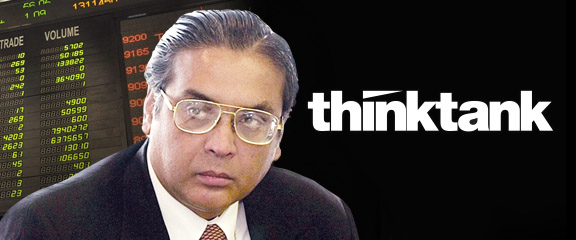The economy of Pakistan has been going through a process of structural adjustment since mid-2018. Following an agreement with the IMF on the Extended Fund Facility, the primary emphasis has been on reducing the current account deficit in the balance of payments, which had reached the unsustainable high level of $18.9 billion in 2018, while foreign exchange reserves had plummeted to $8.5 billion.
Consequently, the country witnessed a process of implementation of extraordinarily tough policies. The federal budget of 2019-20 saw the implementation of the largest ever set of taxation proposals aimed at generating additional revenues of over Rs. 700 billion. The rupee was depreciated by as much as 34 percent and the policy rate of the State Bank of Pakistan (SBP) was enhanced from 6 percent to 13.25 percent.
There was considerable success in reducing the current account by over 62 percent to $7.1 billion in 2019. However, a high price was paid in the form of ‘stagflation’ in the economy. The GDP growth rate, which had been moderately high at close to 4 percent in 2018, dropped to below 2 percent in 2019. The inflation rate, which had been low in 2018 at 5 percent, rose to a double-digit rate of 10.2 percent in 2019.
The IMF Programme was initially a success. Reserves rose to $11.3 billion by the end of 2019 and the first quarterly review was completed. There was growing optimism that following stabilisation of the economy on the external front, it could now move on to a trajectory of relatively high GDP growth.
Unfortunately, the completely unanticipated happened. Like the rest of the world, Pakistan was hit by the pandemic, COVID-19, in the last days of February 2020. The incidence of cases and fatalities rose exponentially, reaching a peak in June. A policy of smart lockdowns was followed to contain the spread.
The outlook for the world economy by the IMF is that there will be a significant recovery in 2021, especially in the second half, after the widespread use of the newly developed vaccines
The economy went into a tailspin and the first half of 2020 saw negative GDP growth of almost 4 percent, for the first time since 1951-52, when there had been a colossal crop failure. The large-scale manufacturing sector saw a drop in output of as large as 17 percent, unprecedented in the history of Pakistan. The informal sector was also disrupted and activity in sectors like wholesale and retail trade, transport and services was badly affected.
The rate of inflation remained high, at over 10 percent in the first half of 2020. Food prices rose faster at over 15 percent, due to the crop shortfall in output of wheat of over 2.5 million tons and a generalised negative impact on agriculture of heavy monsoon rainfall and locust attack.
The world economy was hit even more severely by the pandemic. According to the latest World Economic Outlook report of the IMF, global GDP is expected to fall in 2020 by almost 4.5 percent, equivalent to a decline in income of over $7 trillion. According to the report, world trade is also likely to experience a contraction in volume of 11 percent. Commodity prices are down by 10 percent, with the biggest drop of almost 40 percent in the price of oil.
Pakistan’s external balance of payments has held up well during this great global crisis. Exports did fall by as much as 18 percent in the first half of 2020 but this was more than compensated for by a decline in imports of over 30 percent. Consequently, the position of the current account deficit improved substantially and was down to below $1 billion in the first half of 2020.
Following the COVID-19 outbreak, the IMF Programme has effectively been in a state of suspension. The quarterly performance criteria were no longer attainable and the reform agenda had to be postponed. Thanks are due to the IMF for providing Pakistan quick access to the Rapid Financing Facility of 50 percent of the country’s Special Drawing Rights (SDR) quota, equivalent to $1.4 billion. This partly compensated for the rapid exit of ‘hot money’ of $3 billion from Pakistan soon after COVID-19.
The global GDP growth rate could approach 5 percent, implying full recovery of the loss in 2020. The rate of inflation is expected to remain low at 3 percent
The foreign exchange reserves have consequently held up relatively well due to the big contraction in the current account deficit and stand at over $13 billion on 27 November 2020. These reserves provide import cover of over three months. Following the big decline in COVID-19 cases, the economy was poised once again to go on the recovery path. In fact, the large-scale manufacturing sector had already demonstrated positive growth of almost 5 percent between June and September 2020.
The negative GDP growth and double-digit inflation, along with the COVID-19 health impact in the first half of 2020 were bound to have big negative effects on the lives and livelihoods of the people. It is estimated that almost 5 million workers lost their jobs in these six months and over 20 million more people fell below the poverty line.
The general perception about the state of the economy, which had improved significantly by October 20, has once again been dampened by the beginnings of the second wave of COVID-19. At the time of writing this article, the daily number of cases has reached 60 percent of the peak rate in June 2020 after the first phase.
This brings us to the fundamental question of what are the prospects for 2021. Will the economy recover again soon after the second COVID-19 attack? What is likely to be the state of the global economy in 2021 and what impact will this have on Pakistan? Will Pakistan be able to negotiate a resumption of the IMF Programme on feasible terms of implementation of reforms? As such, we are back once again to a period of uncertainty, added to now by the growing political confrontation between the opposition and the government.
The outlook for the world economy by the IMF is that there will be a significant recovery in 2021, especially in the second half, after the widespread use of the newly developed vaccines in the USA, UK, EU and China. The global GDP growth rate could approach 5 percent, implying full recovery of the loss in 2020. The rate of inflation is expected to remain low at 3 percent.
The prospects for world trade are also positive in 2021, with projected growth in the volume of trade of over 8 percent. Commodity prices are likely to recover and the oil price could once again reach $60 per barrel by the end of 2021.
The overall implications of these projected developments will generally be positive. The economy should get back on the recovery path in the second quarter of 2021. Exports should start growing at a relatively fast rate. However, the rise in oil prices could add almost $3 billion to the import bill by the end of 2021 and lead to more inflation.
The big question mark relates to the future of the IMF Programme. The commitments yet to be implemented relate to the quantum jump in power tariffs to restrict growth in the circular debt and a strong round of tax reforms to enable achievement of the target growth of 24 percent in FBR revenues in 2020-21. Hopefully, given the onset of the second wave of COVID-19, the IMF will agree to a more staggered process of implementation of the reforms.

The resulting projections, based on the above scenario, are presented in Table 1. These projections are summarised below:
(i) The GDP growth rate is projected at 2.5 percent in 2021, with the growth rate rising to 4 percent in the second half of the year.
(ii) The rate of inflation will persist at close to 10 percent in the first half of 2021 and fall to 7 percent in the second half of the year.
(iii) Exports could rise in value terms by over 5 percent in 2021. However, imports could increase faster by almost 8 percent, initially because of larger agricultural imports and subsequently due to the bigger oil import bill. Consequently, the current account of the balance of payments could be transferred from a surplus in the second half of 2020 to a deficit of up to $6 billion in 2021.
(iv) The budget deficit is estimated at 8 percent of the GDP in 2020. With somewhat faster growth in revenues it is projected to fall to 7.5 percent of the GDP in 2021.
(v) The total number of unemployed workers could reach a peak of 10.5 million by the end of the first quarter of 2021, in the aftermath of the second COVID-19 wave. It will, however, start falling thereafter. Simultaneously, the incidence of poverty should also begin to decline.
Overall, the outlook in 2021 for the economy could be somewhat better than the outcomes in 2019 and 2020. There is need for a closing caveat. If talks with the IMF fail, then Pakistan will need to seek a large debt rollover, especially from China, and pursue policies that require stronger containment of imports, leading thereby to more inflationary pressures and less growth. Also, we hope that the problem of the political conundrum will be resolved in early 2021.

Dr. Hafiz A. Pasha
The writer, one of Pakistan’s most distinguished economists, is a Professor Emeritus at Beaconhouse National University and a former Federal Minister of Finance.



